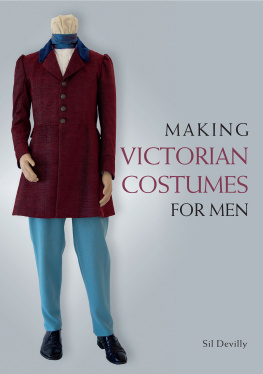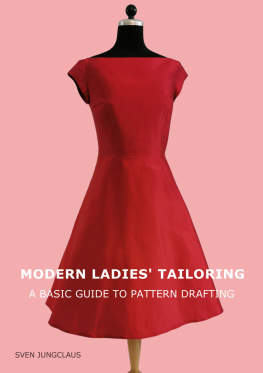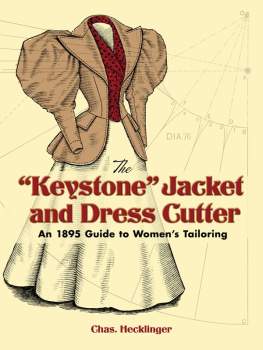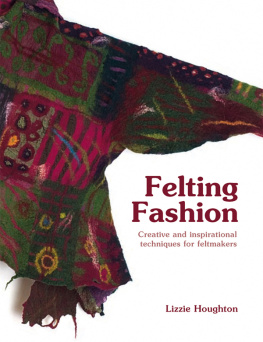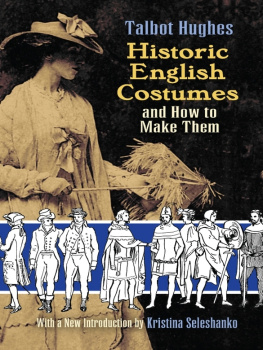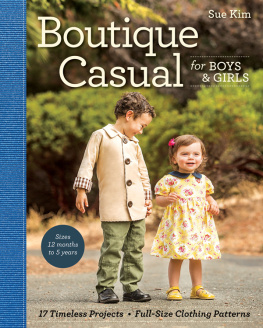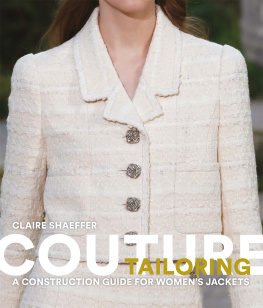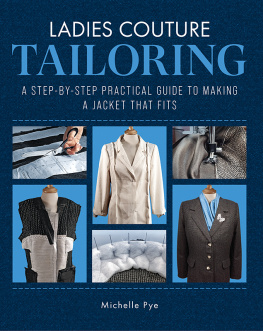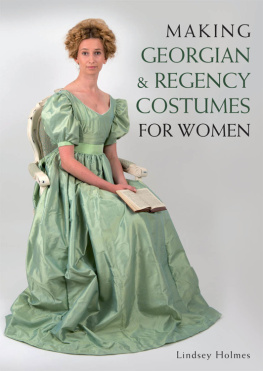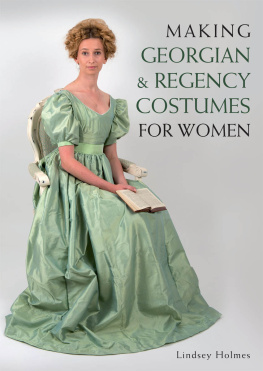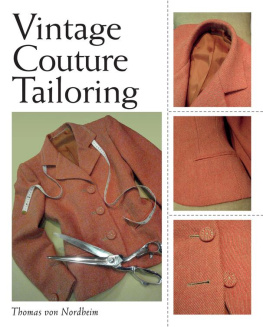MAKING
VICTORIAN
COSTUMES
FOR MEN

MAKING
VICTORIAN
COSTUMES
FOR MEN
Sil Devily

THE CROWOOD PRESS
First published in 2019 by
The Crowood Press Ltd
Ramsbury, Marlborough
Wiltshire SN8 2HR
www.crowood.com
This e-book first published in 2019
Sil Devilly 2019
All rights reserved. No part of this publication may be reproduced or transmitted in any form or by any means, electronic or mechanical, including photocopy, recording, or any information storage and retrieval system, without permission in writing from the publishers.
British Library Cataloguing-in-Publication Data
A catalogue record for this book is available from the British Library.
ISBN 978 1 78500 576 3
Contents
Introduction

Fig. 0.1 Footmen sharing snuff, captioned A Friendly Pinch. From A Practical Guide for the Tailors Cutting Room, XIX Footmans Dresses (National Museums Liverpool). The two footmen are wearing quite different styles of uniform: on the right the livery resembles military uniform; the man on the left is wearing an outfit more closely based on the fashionable dress of the 1840s - a cutaway tailcoat with epaulettes, horizontally striped waistcoat and narrow trousers.
Making Victorian Costumes for Men is designed to guide the reader through the process of creating period gentlemens clothing, using a mixture of traditional and modern tailoring techniques along with costume-making methods.
There are many reasons for making Victorian costume, from wanting to create tailored menswear based on Victorian fashions for theatrical productions or re-enactment to using elements of Victorian costume and adapting them to use as a basis for steampunk, live action role-playing (LARP) or cosplay costume. Each individual costume has its own rationale with endless options and possibilities.
Some of the techniques used are based on traditional methods, although it is impossible to recreate true Victorian tailoring without using both original methods and materials. The idea of this book is to produce garments that may appear to be very much like Victorian mens clothing while using techniques that are appropriate for the materials available to the modern maker, the assumption being that you are going to make a version of costume rather than replica garments.
Although the skills and techniques outlined in this book have been streamlined wherever possible, they are not easy, coming as they do from established tailoring methods. With patience and persistence, allowing yourself to both practise and develop an understanding of the construction systems, you will enhance your coordination and start expanding your sympathy for fabrics and gain a greater feel for the construction process.
Queen Victorias reign lasted sixty- three years, during which there were constant, often subtle, changes to mens clothing within the large and growing population, all of whom had different occupations, incomes and interests. The outfits chosen as construction examples represent portions of this time period when they were popular. Each outfit starts with the coat or jacket and includes the other garments needed to build a complete costume, in order to tell the history of mens clothing through this timespan. The garments and patterns in this book cover a broad spectrum of time and styles; each of the outfits, although based in a specific decade, represents items that were made during a longer period of time and would have been worn by men from many walks of life.
I am a costume maker with over twenty years of experience in costume design interpretation and costume construction. Initially self-taught, I started making costume as a hobby in my free time. I returned to education to learn how to make costume properly and completed the Theatre Wardrobe course in Liverpool. I have worked on a huge variety of costumes, both in theatre workrooms and as a freelance maker ever since.
Every costume-making project is different and provides new opportunities to learn. I have been extremely fortunate to work with a wonderful group of people, colleagues whose generosity has been boundless in sharing with me their hints, tips and techniques picked up during their careers.
Some of my accumulated skills and experience I am able to pass on in my role as a costume construction teacher and lecturer. I hope to use this book as an opportunity to share more of this useful knowledge.
The recent completion of an MA in Creative Pattern Cutting gave me the confidence to take on the writing of this book , which provided my biggest challenge to date - condensing Victorian menswear and the techniques needed to make it into just one book!
It is my intention that this book will be useful to people who are able to sew and who already have an understanding of garment construction and patterns, but who would like to broaden their range of technical abilities. My sincerest wish is to help you enjoy the process of creating Victorian costume for men.
Chapter 1
Exploring Victorian Costume

Fig. 1.1 Illustration from a story in The Strand Magazine from 1894 showing two very different styles of mens dress. Drawings accompanying stories outline the silhouette of clothing worn by the characters but do not show every detail of the garments.
Each period of history has its own distinctive clothing styles influenced by the main themes of the time, including the arts, science, technology and important events. Most fashions progress from existing ideas; there are developments and adaptations of previous styles which can go on to mass popularity if they are taken up by influential people or catch the public mood. Fashions rarely start without a traceable history, demonstrating the evolution of the various influences that subsequently bring about what appeared to be an original innovation.
The Victorian era is one of the longest periods of rule for a monarch. Victoria reigned for sixty-three years from 1837 to 1901. Such a lengthy reign covered many changes in fashion and taste.
The mens clothing covered by this period seems practical and restrained as compared to the flamboyance of womens clothing with its fluctuating skirt, bodice and sleeve shapes; there are resemblances and echoes of the changes in mens dress but with different results. The social conventions of the time applied strict rules to masculine dress, with different occasions demanding stringent dress codes to be adhered to. The upper-class man was expected to change his clothing sometimes several times a day to the appropriate outfit for the occasion.
The growing population produced a new, larger and wealthier middle class, members of which had the disposable income to spend on clothing and used the upper class as a style guide. New cities and larger towns contained more people who were involved in the types of social scenes which required the following of changing clothing trends.
The Development of Mens Costume through Queen Victorias Reign
The Coat
Victorian mens coats changed according to the fashionable shape of the time: waistlines rose and fell; coat skirt lengths varied or became wider or narrower; the coat could be double- or single-breasted; the sleeve fit, shape and cuff changed; and of course the collar and lapels followed the varying fashionable lines. The major coat styles of the period were the frock coat, the tailcoat, the cutaway coat and the short jacket - each style had a variety of names help to distinguish between the different cuts, eras and fashions.
Next page
